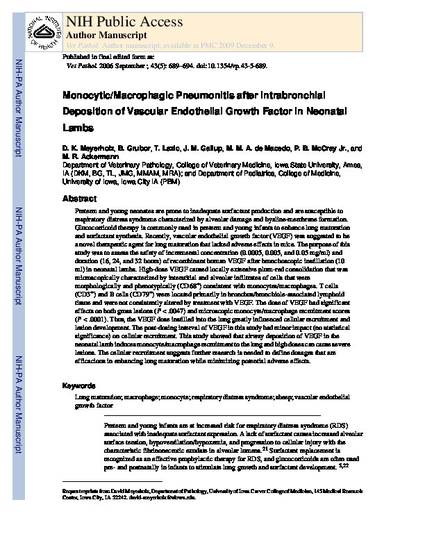
Preterm and young neonates are prone to inadequate surfactant production and are susceptible to respiratory distress syndrome characterized by alveolar damage and hyaline-membrane formation. Glucocorticoid therapy is commonly used in preterm and young infants to enhance lung maturation and surfactant synthesis. Recently, vascular endothelial growth factor (VEGF) was suggested to be a novel therapeutic agent for lung maturation that lacked adverse effects in mice. The purpose of this study was to assess the safety of incremental concentration (0.0005, 0.005, and 0.05 mg/ml) and duration (16, 24, and 32 hours) of recombinant human VEGF after bronchoscopic instillation (10 ml) in neonatal lambs. High-dose VEGF caused locally extensive plum-red consolidation that was microscopically characterized by interstitial and alveolar infiltrates of cells that were morphologically and phenotypically (CD68+) consistent with monocytes/macrophages. T cells (CD3+) and B cells (CD79+) were located primarily in bronchus/bronchiole-associated lymphoid tissue and were not consistently altered by treatment with VEGF. The dose of VEGF had significant effects on both gross lesions (P < .0047) and microscopic monocyte/macrophage recruitment scores (P < .0001). Thus, the VEGF dose instilled into the lung greatly influenced cellular recruitment and lesion development. The post-dosing interval of VEGF in this study had minor impact (no statistical significance) on cellular recruitment. This study showed that airway deposition of VEGF in the neonatal lamb induces monocyte/macrophage recruitment to the lung and high doses can cause severe lesions. The cellular recruitment suggests further research is needed to define dosages that are efficacious in enhancing lung maturation while minimizing potential adverse effects.
Available at: http://works.bepress.com/mark_ackermann/36/

The final, definitive version of this paper has been published in Veterinary Pathology, 43/5, 9/2006 by SAGE Publications, Inc., All rights reserved. © 2006 American College of Veterinary Pathologists.